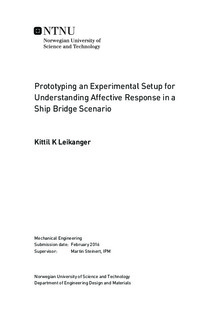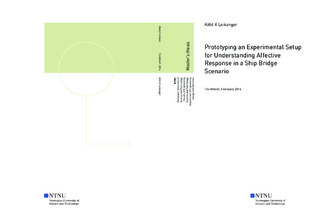| dc.description.abstract | This document concerns the process and outcome of a master project undertaken at the Department of Engineering Design and Materials (IPM) at the Norwegian University of Science and Technology (NTNU) in the fall of 2015. The assignment for the project was to conceptualize, build and conduct an experiment targeting stress and affective response in a ship-handling scenario.
The first chapter gives the background for the thesis assignment. The challenges of the assignment are discussed to explain the approach taken and the evolved aim of the thesis introducing the wayfaring approach for the development of a pilot experiment. Chapter two is presented as a conference paper dedicated to the unprecedented development strategy. This includes the theoretical background for human experiments in interaction design and for the wayfaring model in its current form as an early-phase product development methodology. Furthermore, it provides an overview of the pilot experiment before exemplifying how we deployed the wayfaring approach onto the development process by giving concrete examples highlighting the main aspects of the model. Conclusively, we propose an extended wayfaring model for developing experiments focused on: probing ideas, merging multidisciplinarity, agility and speed. Chapter three provides a comprehensive documentation of the solutions employed in the pilot experiment. This includes descriptions of the technical solutions for physiology measurements and data capturing, ship simulator setup and experimental tasks, as well as protocol solutions. The findings of the data analysis are included in chapter four. Chapter five provides a critical analysis of the pilot experiment and highlights aspects for improving the experimental setup. These issues and more are addressed in chapter six, where we suggest measures for further improvement.
This thesis should be relevant for the reader interested in the following topics:
Affective engineering
Interaction design
Experiment development
The wayfaring model
Physiological measurement tools
Stress | |

